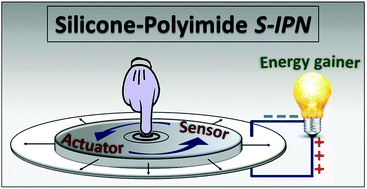Dielectric elastomers with dual piezo-electrostatic response optimized through chemical design for electromechanical transducers†
Abstract
A new class of elastomers that simultaneously shows sensing, actuation and energy conversion functionalities is synthesized to meet the current requirements for electroactive materials. These new materials consist of a silicone network (polydimethylsiloxane-α,ω-diol crosslinked through chain ends) semi-interpenetrated with different percentages (2, 5, and 10 wt%) of polyimide derivatives stepwise modified by different strategies to improve the compatibility with the silicone core network. By addressing the right chemical pathway, the resulting semi-interpenetrated structures (S-IPNs) show noticeable dielectric permittivity, eps′ (up to 11), and breakdown strength, Ebd (up to 88 μm V−1), improvements as compared with the starting polymers (silicone with eps′ = 2.9 and Ebd = 38 μm V−1 and our best polyimide with eps′ = 6.2 and Ebd = 23 μm V−1). The S-IPNs with 10 wt% polyimide are able to gain energy up to 132 mJ cm−3 at 100% strain and up to 164 mJ cm−3 at maximum strain to develop large actuation strain (up to 8.7%) and show very good piezo-response (up to 44 pm V−1), making them highly suitable for cutting-edge electromechanical applications. For a better evaluation, S-IPNs are compared with one of the commercially available dielectric elastomers, most often used for this purpose.



 Please wait while we load your content...
Please wait while we load your content...